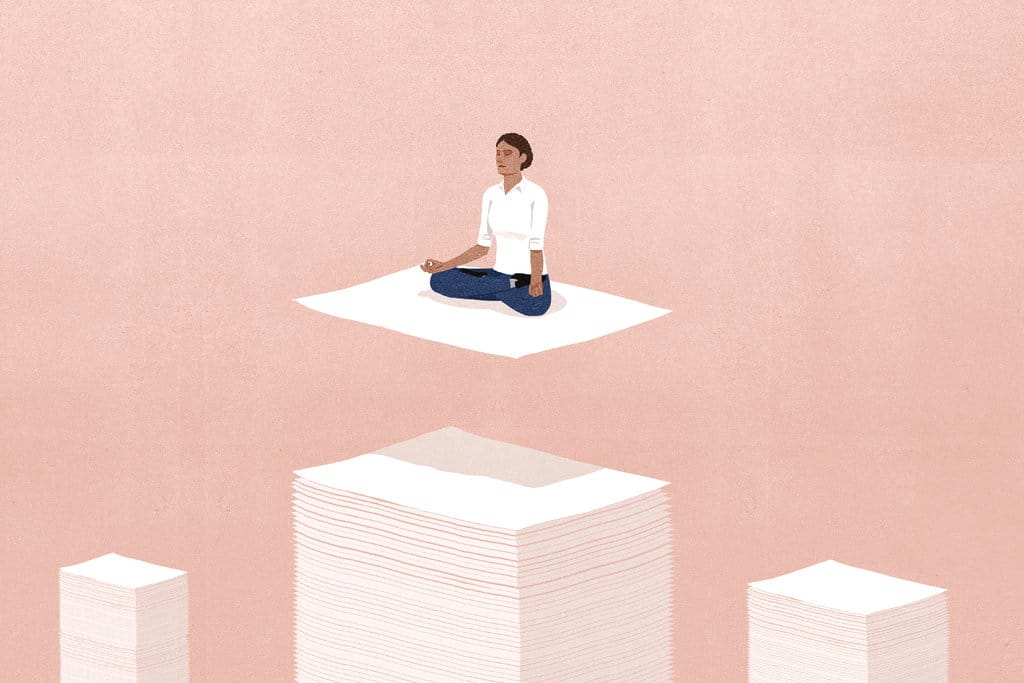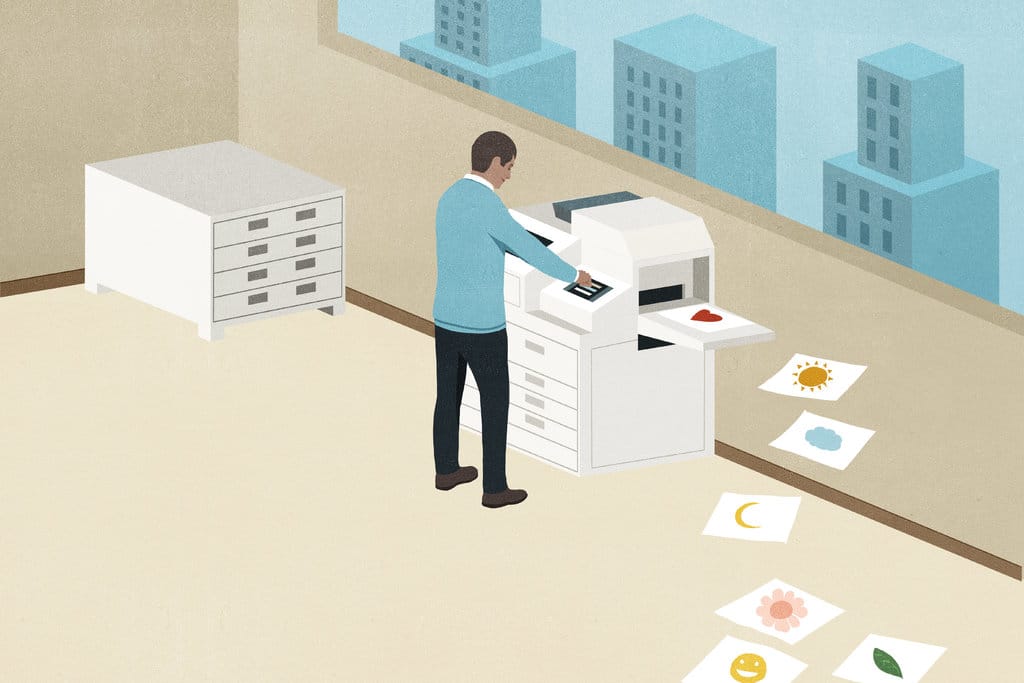Reposted article from The New York Times.
Our jobs pay the bills, occupy many of our waking hours and can even give our lives meaning. They can also be a source of significant stress: tight deadlines, long days and difficult conversations. No matter what your job, work can be anxiety-provoking. Mindfulness can help. In recent years, many companies — from Google to General Mills — have started teaching mindfulness in the office. Whether or not your company does, there are simple ways to reduce the impact workplace stress can have on your mind and body. Here’s a guide to get you started.
What Is Mindfulness?
The Present Moment
Mindfulness — paying attention to the present moment in an accepting, nonjudgmental way — is a simple practice available to all. Research has shown it is also a reliable method for reducing stress, including at work.
Put most simply, meditation is a way to train the mind. Most of the time, our minds are wandering — we’re thinking about the future, dwelling on the past, worrying, fantasizing, fretting or daydreaming. Meditation brings us back to the present moment, and gives us the tools we need to be less stressed, calmer and kinder to ourselves and others.
“I think of mindfulness as the ability not to be yanked around by your own emotions,”
says Dan Harris, the author of “10 Percent Happier.”
“That can have a big impact on how you are in the workplace.”
There are many ways to cultivate mindfulness at work, from walking during the day to taking purposeful pauses when eating. One of the most reliable ways is simple meditation.

Work is stressful. Find focus.
It can be especially helpful to bring a mindful disposition to your job, which can be the source of significant stress. And workplace stress is becoming only more consuming, with email, intra-office chat tools and social media constantly competing for our attention, and often bleeding into the hours that historically gave you a break.
“We are encouraged in the workplace to be attached to an array of technology wizardry 24-7,”
says Janice Marturano, founder of the Institute for Mindful Leadership.
“The information we’re being bombarded with can be anxiety producing and it can create a sense of disconnection that can overwhelm us in our personal and professional lives.”
One way mindfulness can help is simply by allowing us to improve our focus. When we constantly flit from one task to another, the quality of our work can suffer. By practicing mindfulness — simply coming back to the present moment over and over again — we can train ourselves to become more focused.
“This is attention training,”
says Mr. Harris.
“And the neuroscience shows that this daily exercise can boost the areas of the brain that have to do with attention regulation. Multitasking is a pernicious myth that is preventing us from getting our work done.”

Mindfulness
The goal of mindfulness isn’t to stop thinking, or to empty the mind. Rather, the point is to pay close attention to your physical sensations, thoughts and emotions in order to see them more clearly, without making so many assumptions, or making up stories.
Though mindfulness meditation was inspired by Buddhist practices, today it is available as a wholly secular practice that emphasizes stress reduction, the cultivation of focus and the development of tranquility. And today, there’s a large and growing body of research identifying the measurable effects of mindfulness on the body and brain.
Mindfulness meditation isn’t the only way to meditate. Transcendental Meditation, which aims to promote a state of relaxed awareness through the recitation of a mantra, is also popular these days. But mindfulness is taking hold in the business world, from Wall Street to Silicon Valley.

At the Office
Built for distraction
Just because they call them “workplaces” doesn’t mean they’re the best place to do your work. By learning how to focus more effectively, communicate more compassionately and manage our frustrations, we can avoid many of the common pitfalls that lead to dissatisfaction on the job.
“The modern office is built for distraction,”
says Joe Burton, founder of Whil, a meditation app.
“Not just the open-office floor plan, but Slack channels and email. They constantly take you off of task. You’re constantly having to go back and remember where you left off.”

Conscious choices
Even without a formal meditation practice, there are simple steps you can take to give yourself a better chance of staying present:
- Turn off pop-up notifications and push notifications.
- Answer email during dedicated periods of time, rather than constantly throughout the day as soon as it pops into your inbox.
- Finish one task before you begin the next.
“We can make conscious choices about how distracted we will allow ourselves to be all day long,”
says Ms. Marturano.
“This can help you be more productive and focused.”
Try it
When you are experiencing a particularly stressful moment, a popular mindfulness exercise known as S.T.O.P. can be helpful.
Stop. Just take a momentary pause, no matter what you’re doing.
Take a breath. Feel the sensation of your own breathing, which brings you back to the present moment.
Observe. Acknowledge what is happening, for good or bad, inside you or out. Just note it.
Proceed. Having briefly checked in with the present moment, continue with whatever it was you were doing.

Big results
At Aetna, a large health insurance company, more than 10,000 employees have participated in a mindfulness or yoga class that the company offers, resulting in a healthier and more effective workforce. In a study conducted with Duke University, Aetna found that among those who took part, there was a 28 percent reduction in their self-reported stress levels, a 20 percent improvement in their sleep quality and a 19 percent reduction in pain recorded in surveys of the participants. They also became more effective, gaining an average of 62 minutes per week of added productivity.
Mindful meetings
It can also be useful to set some simple guidelines aimed at cultivating a more mindful environment at the office, especially during meetings.
“Meetings can be an incredible waste of time when people aren’t really listening,”
says Ms. Marturano.
“If one eye is on your phone while you’re in a meeting, you’re not really there.”
To stay present, Ms. Marturano suggests some simple rules:
- No phones or computers allowed at meetings, whenever possible.
- If you need a note taker, have one person act as secretary and circulate the notes afterwords.
- Give everyone present the opportunity to speak, uninterrupted.
Frustrations
Even for those who make mindfulness a habit, frustrations are bound to arise at work. Colleagues may let us down, promotions may evade our grasp and deadlines may pile up. When this happens, rather than try to fight the situation, see if it’s possible to approach the situation with some measure of equanimity.
“These are opportunities for reflection,”
says Ms. Marturano.
“Can you formulate a question around it? How does it feel in your body? Be open and curious. Where else do you feel that. Can you pause before you react?”
“Between stimulus and response there is a space. In that space is our power to choose our response. In our response lies our growth and our freedom.”
Viktor Frankl
During difficult conversations, see if it’s possible to listen to what the other person is saying, rather than just stewing in frustration.
“Rather than approaching that conversation as an opportunity to change someone’s mind, see if you can create the habit of trying to understand,”
says Mr. Harris.
“You’ll feel better, and the encounter will go better.”
On the Go

Always working
These days, it can seem like we’re always working, even when we’re not at the office. Here are tips to help you stay in the present moment even when you’re in the elevator or at lunch.
Pausing
Perhaps the simplest thing to do is simply find moments to come back to the present moment throughout the day. Mindfulness isn’t just cultivated by long stretches spent sitting on a meditation cushion. Short moments, many times throughout the day, can have a profound effect on our disposition.
“Just feeling my feet as I walk begins to break through this feeling that I’m on autopilot throughout the day,”
says Mr. Harris.
“If I can be present, rather than amping up my anxiety, that makes a difference in the quality of my day.”
Try it
When you have to wait for a few moments — at the elevator, as your computer turns on or as something prints, rather than take out your phone and check your email, try a Purposeful Pause:
- Take a moment to check in with your body. What does it feel like to take one breath? How does it feel to stand, or sit, with the weight of your body balancing there?
- If your mind wanders, come back to the sensations in your body.
- And when you’re ready, proceed with your day.
“It’s about creating these little opportunities to have a little dose of mindfulness,”
says Mr. Harris.
“Rather than pulling out your phone and walking into a wall, just see what it’s like to feel your legs moving.”
Leaving work at work
Another good habit to get into is being more judicious with technology when we’re not at the office. Try not to check your email incessantly when you’re at home. Do your best to leave work at your workplace. This will help you be more present with friends and family, and also more refreshed when you arrive at the office.
“You don’t have to be perennially woke,” says Mr. Harris. “But it’s about shaving down the amount of time your mind is aimlessly wandering. Maybe taste your first bite of food at lunch.”
A simple exercise, known as R.A.I.N., can help us stay in the present moment and not get caught up clinging to the experiences of others, or our own emotions.
R: Recognize. Acknowledge what is happening, just noting it in a calm and accepting manner.
A: Accept. Allow life to be just as it is, without trying to change it right away, and without wishing it were different somehow.
I: Investigate. See how it feels, whether it is making you upset or happy, giving you pleasure or pain, just note it.
N: Non-Identification. Realize that the sensations you are feeling make for a fleeting experience, one that will soon pass. It isn’t who you are.
For more, check out the author’s book, Mindful Work: How Mindfulness is Changing Business from the Inside Out.
The most recent posts
I’m going back to my roots. Literally. I’ve been highlighting my hair for longer than I’ve had a driver’s license. And this week, without much thought or realization of the significance, I asked my stylist to match the top half of my hair to the bottom half. Under all that blonde, I’m apparently a natural brunette. ...
Read Field Note“Love takes off the masks we fear we cannot live without and know we cannot live within.” James Baldwin Today, we’re living in a divided world of “us” and “them,” of people who think/look like me and those who don’t. When things are going well, when we’re around people like us, it feels easier to ...
Read Field NoteI laughed with my family and colleagues this week sharing that I was this year’s banquet keynote. The class of ‘93 over there is probably laughing too. I also told many of them I’d start this address tonight with a reminder: I’m lucky I finally made my way out of Mr. Evans’ office to speak ...
Read Field Note
Subscribe to our newsletter
Sign up with your email address to receive our monthly newsletter. What do we send your way? Recommended resources, introspective content, information on upcoming events, & more.
